Are you looking for a medium-sized, multipurpose domestic goose breed? The Pilgrim goose is a perfect choice whether you are a beginner or seeking to increase your flock.
The Pilgrim goose is famous for its quiet, docile, and personable temperament. Its personality makes this breed ideal for diverse settings, including urban neighborhoods.
This article delves deep into the Pilgrim goose’s history, characteristics, uses, and more. Read on!
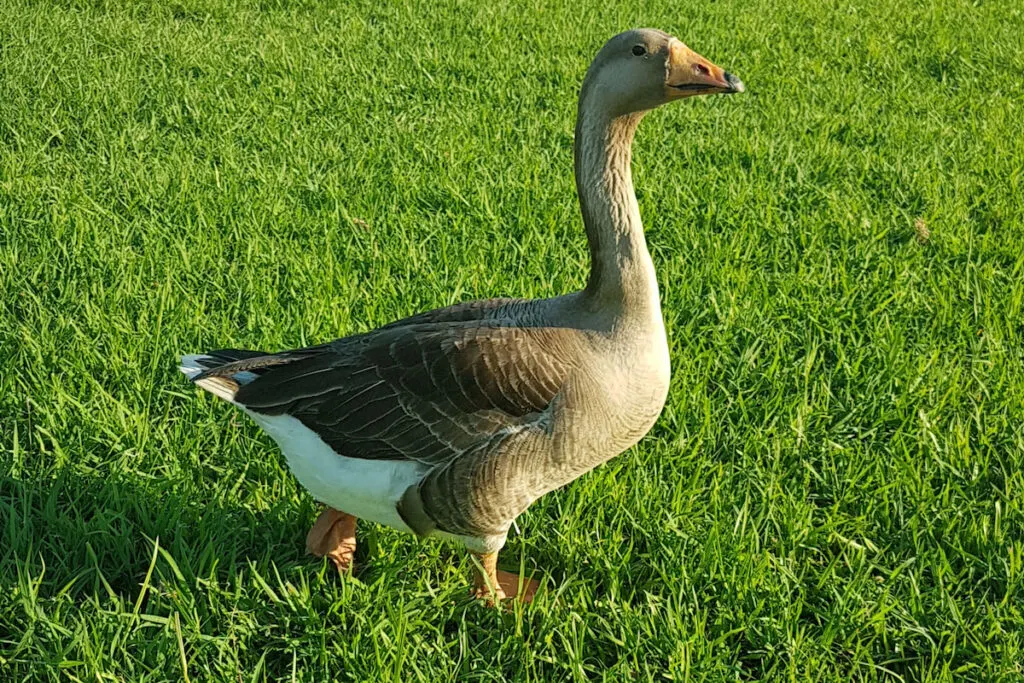
Table of Contents
History and Origin
The origin of the Pilgrim goose is not conclusive. There are different opinions about the breed’s origin.
For instance, a renowned waterfowl breeder named Oscar Grow claimed to have bred and named it in Iowa. According to his claim, his wife called the goose after their pilgrimage from Iowa to Missouri in 1935.
On the other hand, others, such as Robert O. Hawes, believed that the breed originated from Normandy in Europe and western England. The belief is that the Pilgrims brought the goose into America, hence the bird’s name.
In the UK, the standardization of the Pilgrim goose breed was in 1982. The breed first received recognition from the American Poultry Association (APA) in 1939.
In Australia, Andreas Stoll named the breed “Settler goose” in 1989. However, the Australian Poultry Standards recognized it later in 1999.
Is This an APA-Recognized Breed?
The Pilgrim Goose is indeed an APA-recognized goose breed. The breed first got recognition in 1939.
Breed Characteristics

The Pilgrim goose is one of the easiest birds to keep. They are famous for their long lifespan, bountiful meat production, and docile nature.
Below are some of the distinctive characteristics of the domesticated breed.
Size/Weight
The Pilgrim is a medium-sized goose with a plump body. A mature female weighs between 12 and 16 pounds (5.5-7.5 kg), while a male Pilgrim weighs between 14 and 18 pounds (6.5-8 kg).
Head and Neck
The Pilgrim goose has a flattened crown and an average thick, long, and slightly arched neck.
Chest and Stomach
The Pilgrim goose has a smooth and keelless chest. On the other hand, it has rounded lobes on the stomach.
Bills and Knobs
Mature female and male Pilgrim geese have straight, orange bills of medium length. Please note that the Pilgrim goose bills are knob-less.
And if your goose has a knob, it is probably a hybrid.
Feet and Toes
Both full-grown female and male Pilgrim geese have orange feet with webbed toes.
Wings and Tail
An adult Pilgrim goose’s wings are against its body and are very strong. Their tails are medium length.
Color
Adult female geese have dark brown eyes. Also, they have olive-gray plumage with white traces on their faces.
The adult male, that is, the gander, has blue eyes. It has creamy white plumage with gray markings on its rump.
Moreover, the male’s body may have some gray traces.
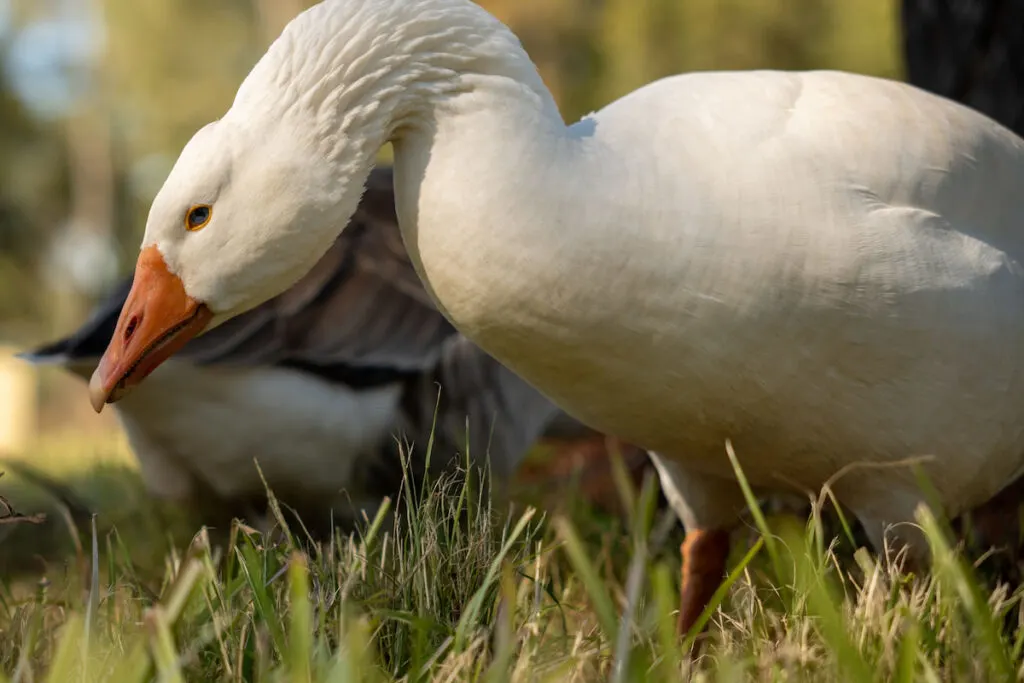
Lifespan
The Pilgrim goose has a lifespan of about 15-25 years. In most cases, the domesticated breed lives longer than in the wild due to quality care.
Also, birds with leaner bodies can live longer than heavier and fatter ones. The primary reason for the difference in longevity is that overweight geese have a higher risk of arthritis and cardiac problems.
Noise Level
The Pilgrim goose is generally quiet. But they can sometimes be very noisy, especially when an intruder approaches.
Also, during the breeding season, the male may hiss and honk at you.
Temperament
The Pilgrim goose breed is relatively quiet and docile. It is curious, friendly, personable, calm, and less aggressive.
Thus, they are a perfect option for homesteading and novices.
In addition, female Pilgrim geese are naturally good parents. Their excellent maternal instincts make them very protective during breeding.

Uses
The Pilgrim goose is suitable for two primary commercial purposes. You can keep them for egg and meat production.
Meat Production
Most people keep the Pilgrim goose for meat production as the bird has a fast growth rate. They also gain weight very fast.
Their hatchlings can gain up to 10 pounds in just two weeks! The birds produce incredibly flavored and less greasy meat compared to other breeds.
Egg Production
The Pilgrim goose’s eggs are significantly larger than other birds, such as chickens. Also, the eggs have more yolk, ensuring they are rich in fat and protein.
A female goose can lay 35-45 eggs annually with proper management. Many farmers, however, prefer to use the eggs for breeding purposes rather than consumption.
The Pilgrim goose eggs weigh between 6 and 7 ounces (170-198 grams).
Other Uses
Apart from meat and egg production, you can keep these birds for:
Aesthetics and Home Beautification
The Pilgrim geese are lovely and produce very cute goslings. Also, they have decorative and elegant traits.
Watch Dogs
The bird has strong vision that makes it aware of its environment. The excellent sight ensures that Pilgrim geese can alert you in case of an intrusion.
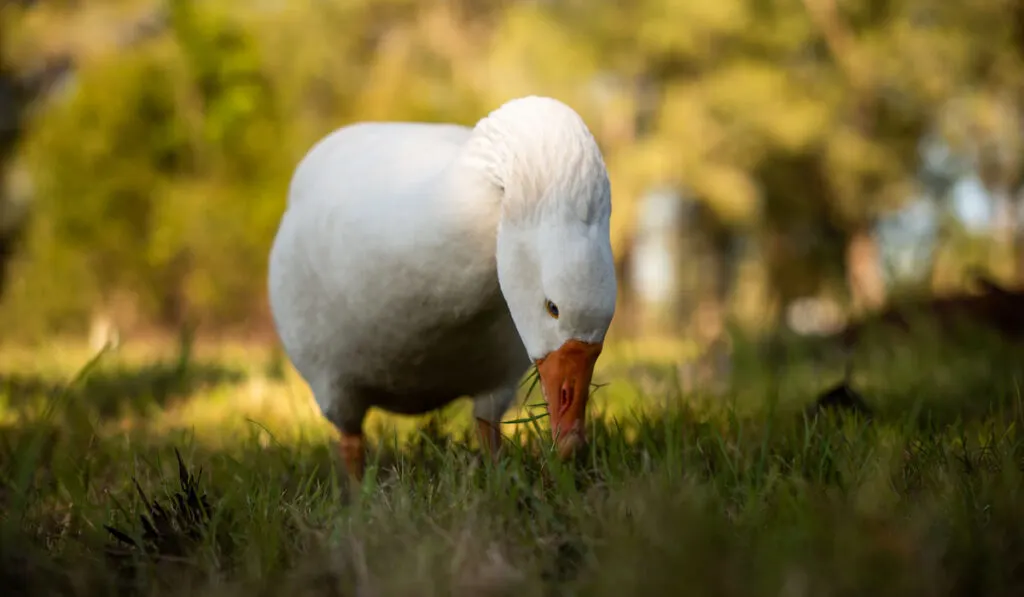
Sexing (How to Tell Male From Female)
You can quickly differentiate between male and female Pilgrim geese by their color. This feature is known as auto-sexing.
As mentioned earlier, the male and female Pilgrim geese have distinctively different plumage colors. Males are much more white with occasional gray, while females are mostly gray with white accents.
Cold and Heat Tolerance
With proper care, the Pilgrim geese are adaptable to diverse weather conditions.
They are cold hardy; they have dense plumage, insulating them against the cold.
During hot weather, the birds control their body temperatures by:
- Relaxing under shade
- Panting
- Splashing or swimming in water
However, provide your birds shade to help prevent heat stress in the scorching sun. Also, ensure the coop is sufficiently ventilated.
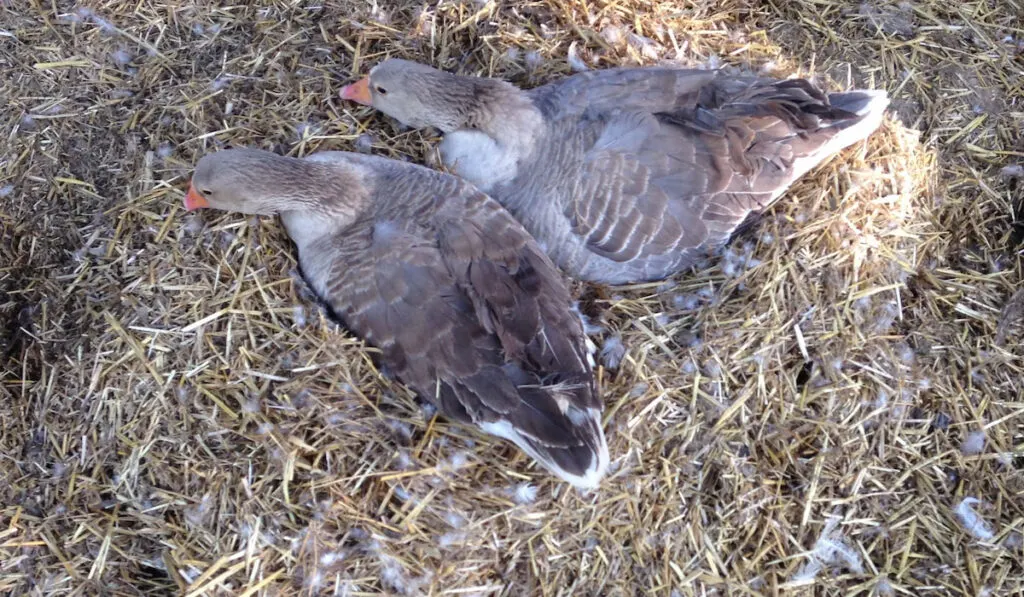
Hatching/Raising
Brooding
The incubation period of the Pilgrim goose eggs is 30 days.
As discussed earlier, female Pilgrim geese have strong maternal instincts.
Thus, they go broody after laying a clutch of 8 to 10 eggs. But you can opt for an incubator.
When using the incubator, make sure that the temperature ranges between 99.32°F and 99.68°F (37.4°C-37.6°C). Also, avoid cramming the eggs to prevent the shells from cracking.
Hatching
The Pilgrim goose eggs will start hatching after 30 days of incubation. The female bird will actively protect her eggs and goslings during this period.
They will start honking and hissing if you approach their nest.
One important thing to note about Pilgrim geese hatchling is that not all the eggs will hatch, as the bird’s eggs have a hatch rate of 50%.
Feeding
Feed your newly hatched Pilgrim goslings unmedicated chick crumbs for the initial few weeks. Remember to check that the crumbs are unmedicated.
It would be best to allow them into the water only after they grow feathers. You can use one cat bowl for their water and another for their food, placing them far from each other.
As the goslings grow, they will gradually start foraging. Eventually, they can begin feeding on plant materials, such as weeds and dandelions.
In addition, the birds feed on crabs, snails, small fish, seeds, aquatic animals, pupae, and larvae.
Housing
The Pilgrim goose is happiest when it has ample space to explore and roam.
A garage shed or barn can serve them well if you provide them with good ventilation.
But ensure that it is predator-proof. Ensure that your birds’ housing has sufficient space.
The recommendable floor spacing per goose is at least one square meter. You can use dirt, wooden, or concrete flooring.
You must note that geese often sleep for prolonged periods on the ground. Ensure you have straw or wood shavings as bedding for comfort.
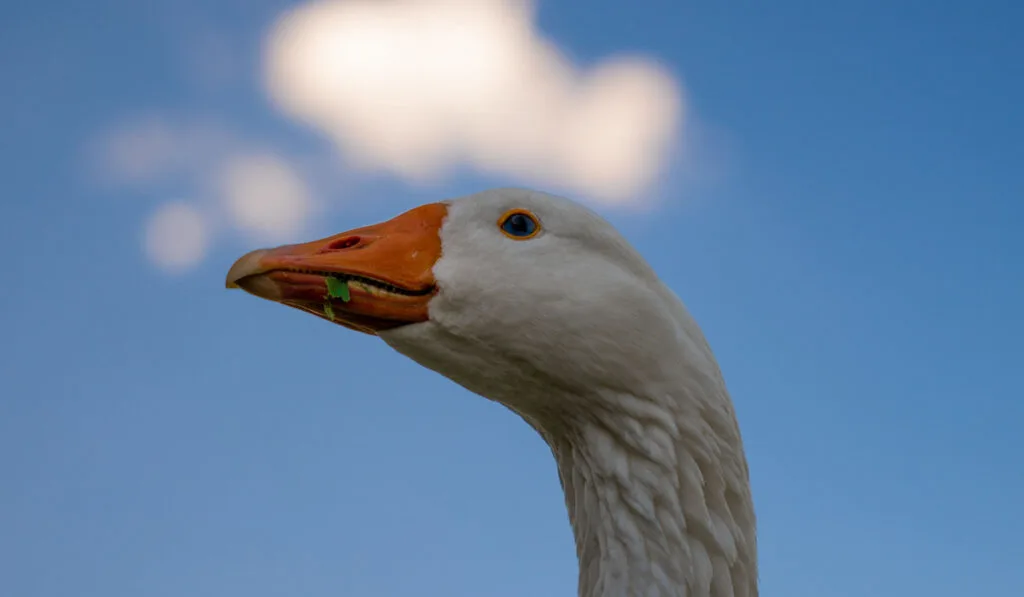
Fencing
Protecting your Pilgrim goose from predators is vital. The birds love to explore, forage, swim, and bask in the sun.
Thus, a safe outdoor area is essential during the day. To promote safety, you need a fully enclosed space that will protect your birds from predators that can jump or climb.
Remember, predators like coyotes or foxes can jump over 5 feet. Therefore, ensure your fencing is more than 8 feet high.
Also, if your region has digging predators, ensure you bury a significant part of the fence in the ground.
Health Issues
The Pilgrim goose is a resilient bird that rarely falls ill. However, they tend to hide signs of sickness; you may not realize when they get sick until it gets to a severe stage.
Therefore, if you are a new owner, you must keep a close eye on your birds. This way, you will get accustomed to their normal behavior, making it easy to notice changes.
Some of the signs that should worry you in your Pilgrim goose include:
- Lack of appetite
- Separating from other flock members
- Inactivity
- Diarrhea
- Keeps falling over
- Constant head shaking
- Runny nose
Some of the common health issues that the Pilgrim geese may suffer from include:
- Coccidiosis
- Fowl cholera
- Botulism
- Aspergillosis
To ensure the health and well-being of your birds, schedule routine checks by your vet. The assessments will help you detect and address any symptoms in good time.
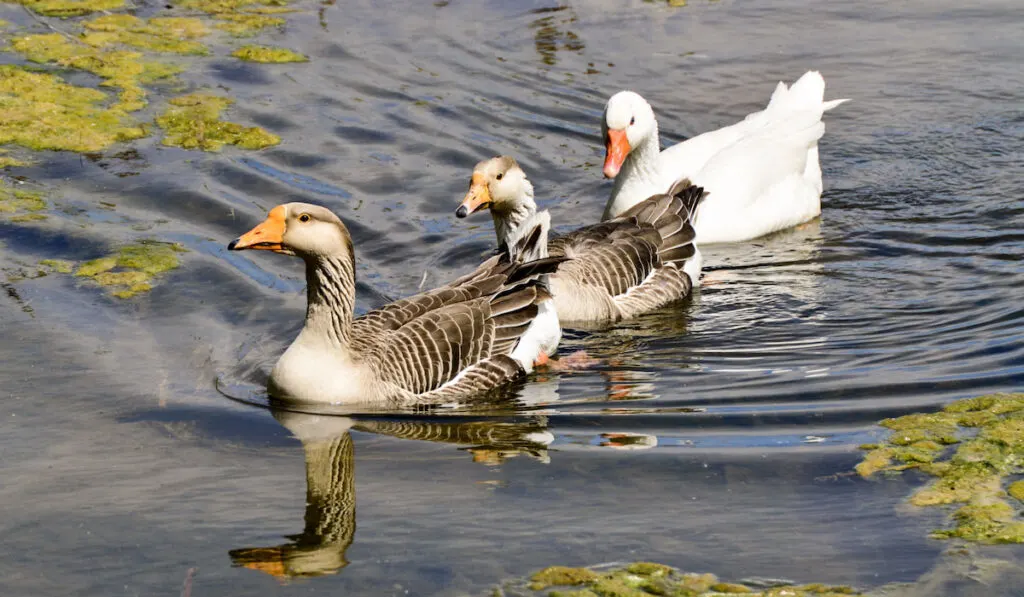
Pros and Cons
Like other birds, raising the Pilgrim goose has several merits and demerits.
Pros
- The Pilgrim geese are docile, friendly, and easy to handle.
- The Pilgrim geese are gorgeous.
- The Pilgrim geese have a long lifespan; they can live up to 25 years.
- The Pilgrim geese are excellent foragers.
- The Pilgrim geese are easy to maintain compared to other birds, such as ducks and chickens.
- The Pilgrim geese are excellent weeders, making them ideal for homesteading.
- The Pilgrim geese can act as excellent watchdogs; they will alert you of an intruder.
- The Pilgrim geese produce quality, delicious meat.
- The Pilgrim geese are intermediate layers, giving you up to 45 eggs annually.
- The Pilgrim geese are highly resistant to diseases.
Cons
- The Pilgrim geese can be noisy sometimes.
- The Pilgrim geese love roaming around. Thus, you may be unable to constrain them without building a fence on your property.
- The Pilgrim geese can chew on almost anything if you allow them to roam freely.
- The Pilgrim geese do not show any early signs of illnesses, which may be dangerous and fatal for inexperienced owners.
Final Thoughts
The Pilgrim goose is an excellent option if you want to start your domestic bird-keeping journey. The bird is easy to maintain and an excellent meat and egg source.
Besides its lengthy lifespan, the Pilgrim goose rarely falls ill. Therefore, you will enjoy the company of this feathered friend for longer should you choose it as your homesteading companion.
Resources
I wrote this article from my experience raising geese and the following sources:
- https://livestockconservancy.org/heritage-breeds/heritage-breeds-list/Pilgrim-goose/
- https://en.wikipedia.org/wiki/American_Livestock_Breeds_Conservancy
- https://www.waterfowl.org.uk/wp-content/uploads/2021/07/Oscar-Grow-and-the-Pilgrim-Goose.pdf
- https://www.ncbi.nlm.nih.gov/pmc/articles/PMC8774782/
- https://www.rspca.org.uk/adviceandwelfare/farm/farmanimals/ducksandgeese/indoorenvironment
- https://academic.oup.com/jhered/article-abstract/30/2/55/808793
- https://www.waterfowl.org.uk/domestic-waterfowl/domestic-geese/light-geese/Pilgrim-goose/
